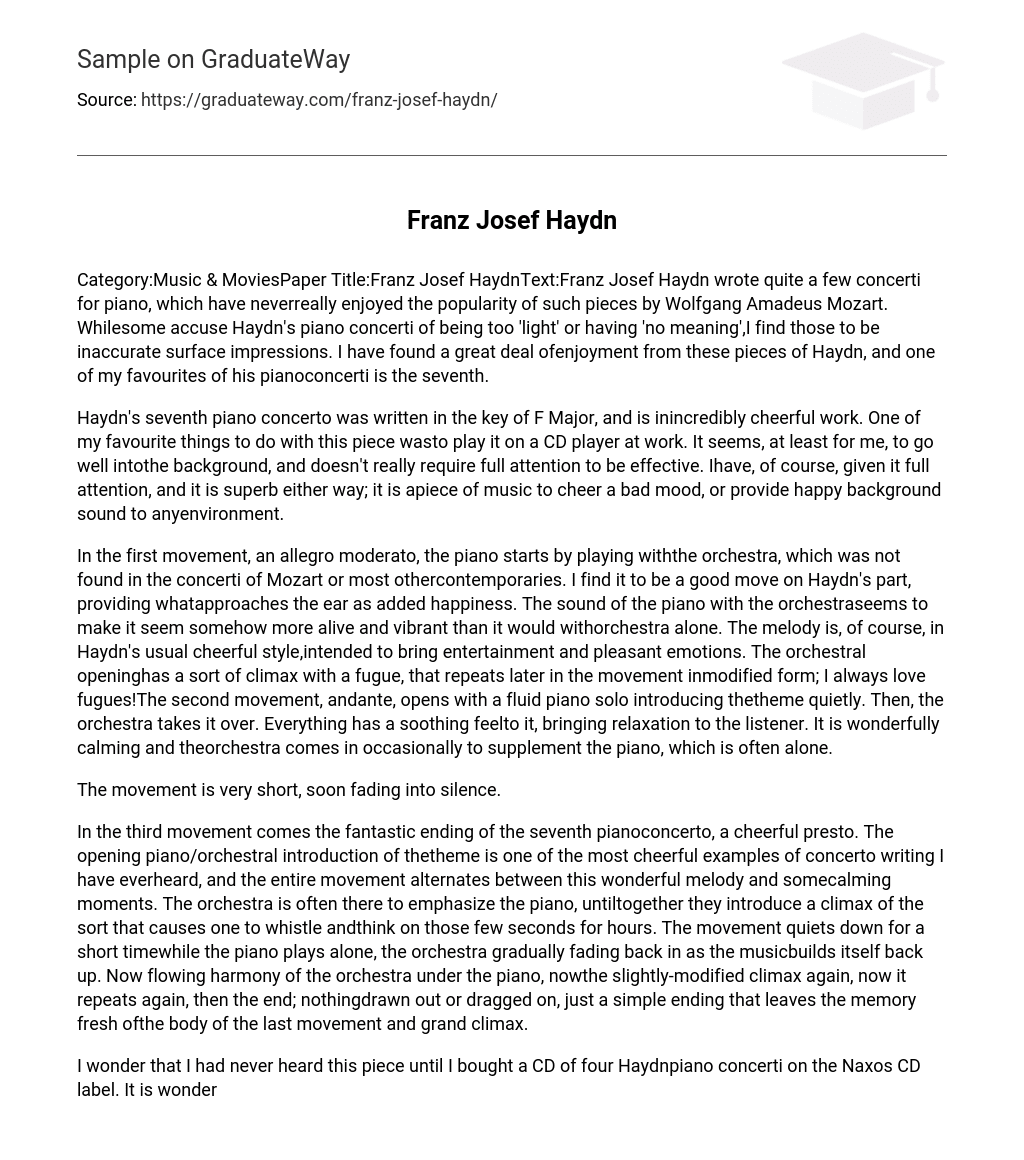Franz Josef Haydn wrote quite a few concerti for piano, which have neverreally enjoyed the popularity of such pieces by Wolfgang Amadeus Mozart. Whilesome accuse Haydn’s piano concerti of being too ‘light’ or having ‘no meaning’,I find those to be inaccurate surface impressions. I have found a great deal ofenjoyment from these pieces of Haydn, and one of my favourites of his pianoconcerti is the seventh.
Haydn’s seventh piano concerto was written in the key of F Major, and is inincredibly cheerful work. One of my favourite things to do with this piece wasto play it on a CD player at work. It seems, at least for me, to go well intothe background, and doesn’t really require full attention to be effective. Ihave, of course, given it full attention, and it is superb either way; it is apiece of music to cheer a bad mood, or provide happy background sound to anyenvironment.
In the first movement, an allegro moderato, the piano starts by playing withthe orchestra, which was not found in the concerti of Mozart or most othercontemporaries. I find it to be a good move on Haydn’s part, providing whatapproaches the ear as added happiness. The sound of the piano with the orchestraseems to make it seem somehow more alive and vibrant than it would withorchestra alone. The melody is, of course, in Haydn’s usual cheerful style,intended to bring entertainment and pleasant emotions.
The orchestral openinghas a sort of climax with a fugue, that repeats later in the movement inmodified form; I always love fugues!The second movement, andante, opens with a fluid piano solo introducing thetheme quietly. Then, the orchestra takes it over. Everything has a soothing feelto it, bringing relaxation to the listener. It is wonderfully calming and theorchestra comes in occasionally to supplement the piano, which is often alone.
The movement is very short, soon fading into silence. In the third movement comes the fantastic ending of the seventh pianoconcerto, a cheerful presto. The opening piano/orchestral introduction of thetheme is one of the most cheerful examples of concerto writing I have everheard, and the entire movement alternates between this wonderful melody and somecalming moments. The orchestra is often there to emphasize the piano, untiltogether they introduce a climax of the sort that causes one to whistle andthink on those few seconds for hours.
The movement quiets down for a short timewhile the piano plays alone, the orchestra gradually fading back in as the musicbuilds itself back up. Now flowing harmony of the orchestra under the piano, nowthe slightly-modified climax again, now it repeats again, then the end; nothingdrawn out or dragged on, just a simple ending that leaves the memory fresh ofthe body of the last movement and grand climax.
I wonder that I had never heard this piece until I bought a CD of four Haydnpiano concerti on the Naxos CD label. It is wonderful, most especially the thirdmovement, which I will listen to repeatedly. On a list of happy music withpiano, this ranges up near Mozart’s concerto works for that instrument, at leastfor me. If you want something you may not have heard before, something cheerful,something happy, you might want to give this piece a try. Haydn’s neglectedseventh piano concerto is a work that may bring you a great deal of pleasure;try it after a long, hard day at work and see what you think!





